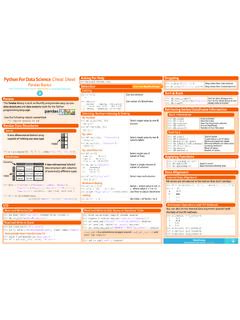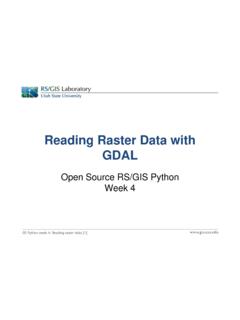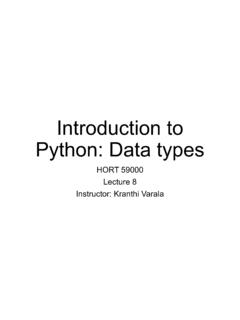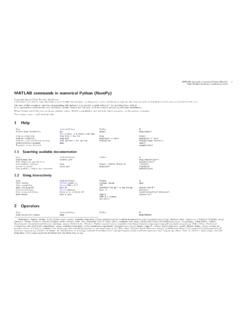Transcription of Parallel Computing in Python using mpi4py
1 Parallel Computing in Python using mpi4py Stephen Weston Yale Center for Research Computing Yale University June 2017. Parallel Computing modules There are many Python modules available that support Parallel Computing . See for a list, but a number of the projects appear to be dead. mpi4py multiprocessing jug Celery dispy Parallel Python Notes: multiprocessing included in the Python distribution since version Celery uses different transports/message brokers including RabbitMQ, Redis, Beanstalk IPython includes Parallel Computing support Cython supports use of OpenMP. S. Weston (Yale) Parallel Computing in Python using mpi4py June 2017 2 / 26. Multithreading support Python has supported multithreaded programming since version However, the C implementation of the Python interpreter (CPython) uses a Global Interpreter Lock (GIL) to synchronize the execution of threads.
2 There is a lot of confusion about the GIL, but essentially it prevents you from using multiple threads for Parallel Computing . Instead, you need to use multiple Python interpreters executing in separate processes. For Parallel Computing , don't use multiple threads: use multiple processes The multiprocessing module provides an API very similar to the threading module that supports Parallel Computing There is no GIL in Jython or IronPython Cython supports multitheaded programming with the GIL disabled S. Weston (Yale) Parallel Computing in Python using mpi4py June 2017 3 / 26. What is MPI? Stands for Message Passing Interface . Standard for message passing library for Parallel programs MPI-1 standard released in 1994. Most recent standard is (not all implementations support it). Enables Parallel Computing on distributed systems (clusters).
3 Influenced by previous systems such as PVM. Implementations include: Open MPI. MPICH. Intel MPI Library S. Weston (Yale) Parallel Computing in Python using mpi4py June 2017 4 / 26. The mpi4py module Python interface to MPI. Based on MPI-2 C++ bindings Almost all MPI calls supported Popular on Linux clusters and in the SciPy community Operations are primarily methods on communicator objects Supports communication of pickleable Python objects Optimized communicaton of NumPy arrays API docs: S. Weston (Yale) Parallel Computing in Python using mpi4py June 2017 5 / 26. Installing mpi4py Easy to install with Anaconda: $ conda create -n mpi mpi4py numpy scipy Already installed on Omega and Grace clusters: $ module load Langs/ Python $ module load Libs/ mpi4py . $ module load Libs/NUMPY. $ module load Libs/SCIPY. S. Weston (Yale) Parallel Computing in Python using mpi4py June 2017 6 / 26.
4 Minimal mpi4py example In this mpi4py example every worker displays its rank and the world size: from mpi4py import MPI. comm = print("%d of %d" % ( (), ())). Use mpirun and Python to execute this script: $ mpirun -n 4 Python Notes: MPI Init is called when mpi4py is imported MPI Finalize is called when the script exits S. Weston (Yale) Parallel Computing in Python using mpi4py June 2017 7 / 26. Running MPI programs with mpirun MPI distributions normally come with an implementation-specific execution utility. Executes program multiple times (SPMD Parallel programming). Supports multiple nodes Integrates with batch queueing systems Some implementations use mpiexec . Examples: $ mpirun -n 4 Python # on a laptop $ mpirun --host n01,n02,n03,n04 Python $ mpirun --hostfile Python $ mpirun Python # with batch queueing system S. Weston (Yale) Parallel Computing in Python using mpi4py June 2017 8 / 26.
5 Point to point communcations send and recv are the most basic communication operations. They're also a bit tricky since they can cause your program to hang. (obj, dest, tag=0). (source= SOURCE, tag= TAG, status=None). tag can be used as a filter dest must be a rank in communicator source can be a rank or SOURCE (wild card). status used to retrieve information about recv'd message These are blocking operations S. Weston (Yale) Parallel Computing in Python using mpi4py June 2017 9 / 26. Example of send and recv from mpi4py import MPI. comm = size = (). rank = (). if rank == 0: msg = 'Hello, world'. (msg, dest=1). elif rank == 1: s = (). print "rank %d: %s" % (rank, s). S. Weston (Yale) Parallel Computing in Python using mpi4py June 2017 10 / 26. Ring example send and recv are blocking operations, so be careful, especially with large objects!
6 S = range(1000000). src = rank - 1 if rank != 0 else size - 1. dst = rank + 1 if rank != size - 1 else 0. (s, dest=dst) # This will probably hang m = (source=src). The chain of send's can be broken using : if rank % 2 == 0: (s, dest=dst). m = (source=src). else: m = (source=src). (s, dest=dst). S. Weston (Yale) Parallel Computing in Python using mpi4py June 2017 11 / 26. Collective operations High level operations Support 1-to-many, many-to-1, many-to-many operations Must be executed by all processes in specified communicator at the same time Convenient and efficient Tags not needed root argument used for 1-to-many and many-to-1 operations S. Weston (Yale) Parallel Computing in Python using mpi4py June 2017 12 / 26. Communicators Objects that provide the appropriate scope for all communication operations intra-communicators for operations within a group of processes inter-communicators for operations between two groups of processes WORLD is most commonly used communicator S.
7 Weston (Yale) Parallel Computing in Python using mpi4py June 2017 13 / 26. Collectives: Barrier (). Synchronization operation Every process in communicator group must execute before any can leave Try to avoid this if possible S. Weston (Yale) Parallel Computing in Python using mpi4py June 2017 14 / 26. Collectives: Broadcast (obj, root=0). S. Weston (Yale) Parallel Computing in Python using mpi4py June 2017 15 / 26. Collectives: Scatter and Gather (sendobj, root=0) - where sendobj is iterable (sendobj, root=0). S. Weston (Yale) Parallel Computing in Python using mpi4py June 2017 16 / 26. Collectives: All Gather (sendobj) - where sendobj is iterable S. Weston (Yale) Parallel Computing in Python using mpi4py June 2017 17 / 26. Collectives: All to All (sendobj) - where sendobj is iterable S. Weston (Yale) Parallel Computing in Python using mpi4py June 2017 18 / 26.
8 Collectives: Reduction operations (sendobj, op= , root=0). (sendobj, op= ). reduce is similar to gather but result is reduced . allreduce is likewise similar to allgather MPI reduction operations include: S. Weston (Yale) Parallel Computing in Python using mpi4py June 2017 19 / 26. Sending pickleable Python objects Generic Python objects can be sent between processes using the lowercase . communication methods if they can be pickled. import numpy as np from mpi4py import MPI. def rbind(comm, x): return ( (x)). comm = x = (4, dtype= ) * (). a = rbind(comm, x). S. Weston (Yale) Parallel Computing in Python using mpi4py June 2017 20 / 26. Sending buffer-provider objects Buffer-provider objects can be sent between processes using the uppercase . communication methods which can be significantly faster. import numpy as np from mpi4py import MPI.
9 Def rbind2(comm, x): size = (). m = ((size, len(x)), dtype= ). ([x, ], [m, ]). return m comm = x = (4, dtype= ) * (). a = rbind2(comm, x). S. Weston (Yale) Parallel Computing in Python using mpi4py June 2017 21 / 26. Parallel map The map function can be parallelized x = range(20). r = map(sqrt, x). The trick is to split x into chunks, compute on your chunk, and then combine everybody's results: m = int( (float(len(x)) / size)). x_chunk = x[rank*m:(rank+1)*m]. r_chunk = map(sqrt, x_chunk). r = (r_chunk). S. Weston (Yale) Parallel Computing in Python using mpi4py June 2017 22 / 26. K-Means Algorithm repeat nstart times Randomly select K points from the data set as initial centroids do Form K clusters by assigning each point to closet centroid Recompute the centroid of each cluster until centroids do not change Compute the quality of the clustering if this is the best set of centroids found so far Save this set of centroids end end S.
10 Weston (Yale) Parallel Computing in Python using mpi4py June 2017 23 / 26. Sequential K-Means using SciPy import numpy as np from import kmeans, whiten obs = whiten( (' ', dtype=float, delimiter=',')). K = 10. nstart = 100. (0) # for testing purposes centroids, distortion = kmeans(obs, K, nstart). print('Best distortion for %d tries: %f' % (nstart, distortion)). S. Weston (Yale) Parallel Computing in Python using mpi4py June 2017 24 / 26. K-Means example import numpy as np from import kmeans, whiten from operator import itemgetter from math import ceil from mpi4py import MPI. comm = rank = (); size = (). (seed=rank) # XXX should use Parallel RNG. obs = whiten( (' ', dtype=float, delimiter=',')). K = 10; nstart = 100. n = int(ceil(float(nstart) / size)). centroids, distortion = kmeans(obs, K, n). results = ((centroids, distortion), root=0).






